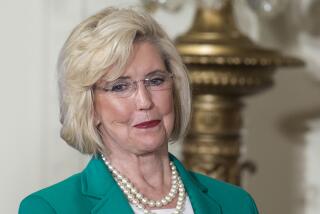Bureau Turns 65 but Won’t Retire Yet
- Share via
“No woman on Earth is worth more than $2,000 a year,” Sen. Reed Smoot (R-Utah) once said on the floor of the U.S. Senate.
That was in 1920, on the day Congress debated establishing a special department within the U.S. Department of Labor to represent women workers.
If the Senate viewed the world as a men’s club, not all of the members in the House of Representatives were enthusiastic either. The Labor Department “is turning loose dangerous anarchists faster than the Department of Justice can apprehend them,” Rep. Thomas Lindsey Blanton (D-Tex.) said.
“Men may long for the days when the spinning wheel helped to make the family income meet the family need,” said Rep. John MacCrate (R-N.Y.).
Nevertheless, Congress voted--with 126 abstentions--to continue the work of an Ordnance Department agency that had been established to protect the health and safety of female defense plant workers during World War I.
Marking Its Birthday
The Women’s Bureau is celebrating its 65th birthday this year. The current director, Lenora Cole Alexander, appointed by President Reagan in 1981, observed the occasion by writing highlights of the bureau’s history, which includes the remarks of the congressmen, for the bureau’s bulletin.
The first director of the bureau, Mary Anderson, a Swedish immigrant who had worked for $1.50 a week as a domestic, led the bureau through an uphill struggle, Alexander wrote. A persistent charge was that the agency was “un-American.” The new bureau was accused of “trying to further Soviet and Bolshevik programs in the United States.”
Among the “Bolshevik” notions of the bureau was its initial concern with the welfare of mothers and children. Its first major objective was to eliminate several million working “women” from the labor force--girls (and boys), 10 to 15, who worked alongside adults as much as 60 hours a week in low-paying, often dangerous jobs. Congress eventually abolished most child labor with the Fair Labor Standards Act of 1938.
Perhaps no other department of government has had to change so much with the times. The bureau has moved from an agency battling child labor to one advocating child care. Concentration on conditions in women’s labor ghettos such as mills and laundries has been replaced by issues such as advancing women in male-dominated fields and comparable worth. When the bureau began in 1920, about 8.5 million females were in the labor force, counting workers from the age of 10. Today there are more than 51 million female workers, and children younger than 16 aren’t included in the figure.
Along with child labor, the bureau focused in its early years on documenting the wages, hours and working conditions of women in order to bring reform. Its initial resources were a $30,000 budget and a staff of 20 with authority only to investigate and “from time to time publish the results.” The bureau issued reports documenting conditions of women working in the sewing trades, canneries, cotton mills, laundries, offices, department stores and as household workers and made hundreds of recommendations ranging from machine safeguards to providing chairs in workplaces.
In the 1930s, with the passage of wage and hour laws, the bureau turned to working to extend the laws to women and sex discrimination in employment became an issue. And there was another uphill struggle, defending working women from the charge that they were taking jobs away from men during the Depression. “Marital status as a basis for employment or dismissal is not sound,” the bureau said in 1933.
With World War II, the needs and the bureau’s work changed radically again. Sex discrimination was put aside while the bureau initiated training programs to equip women to work in the defense industry.
Other Issues Emerge
The sex-discrimination issue, of course, was back with a vengeance when the war plants wound down and the men returned to work, and the bureau turned in the 1950s and ‘60s to issues including equal pay, equal education and job training for women.
In the 1970s, one of the adjustments for the bureau was dealing with the enormous increase in numbers of women in the workplace. It was no longer primarily responsible for job safety or getting employers to hire women, but rather with increasing opportunities for women on the job.
The issues of the Women’s Bureau in the 1980s, Alexander said, include advocating employer-sponsored child care, increasing women’s opportunities in nontraditional jobs and providing training for older women, minority women, women in poverty and displaced homemakers. It has 10 field offices across the country.
More to Read
Get the L.A. Times Politics newsletter
Deeply reported insights into legislation, politics and policy from Sacramento, Washington and beyond. In your inbox twice per week.
You may occasionally receive promotional content from the Los Angeles Times.










